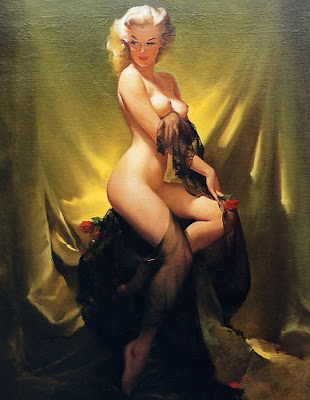I'm also going to start talking about and showcasing pin-up work by some of the greats in the business. Most pin-up work done today is done by comic artists or otherwise childish realists for more-or-less pornographic purposes.
I'm of the mind that pornography is not a thing, per se, but a quality. An image of a naked man or women can have a pornographic quality to it while also possessing artistic qualities. Obviously the determination of whether it is "porn" or not is to what degree the work possesses both. Even the rankest amateur internet porn possesses artistic qualities. The people making it made decisions about lighting, sound, body positions, and camera angle. All of that is art. The end result is very basic art and exists primarily so someone can pull some pud to it, but the art is there.
All of my work has a pornographic element to it. If we define art as something within a work meant to communicate an idea, as I argued on my Candle in the Dark blog, then pornography is a work meant to elicit a sexual response. That means there is pornographic elements all over the place. My work is of sexy women, so of course pornography is a part of it. If I did nothing but still-lifes of fruit, then I think that then my work would have no porn in it.
Pin-up artists of old used their work to stretch some serious artistic muscle and to communicate ideas beyond just "hot chick." They wanted to communicate situations, character, events, sex, friendship, and many other ideas. Compare some of the best, Gil Elvgren and Greg Hildebrant, with one that's technically good but artistically void.
 Gil Elvgren: A Warm Welcome. 1959. Oil on canvas.
Gil Elvgren: A Warm Welcome. 1959. Oil on canvas. Greg Hildebrandt
Greg Hildebrandt Carlos Diez
Carlos DiezNotice a difference? Diez's type of work is for the Heavy Metal Magazine crowd (Fantasy and boobs?! There's nothing better!). Comic-oriented, heavily pornographic, technically good but lacking the texture and staging of the works by better artists. Whereas Hildebrandt and Elvgren made a character and story in an an image worth a thousand words, Diez's can be summed up with "hot, wet chick with big boobs."
I don't want to completely deride the removal of staging, since there are other pin-up artists that communicate everything they want to communicate through the image of the woman and sparse other elements. Hajime Sorayama, for example, has little staging but elevates his erotica to such an extreme point as to make it an artistic statement in and of itself.
 Hajime Sorayama
Hajime SorayamaThe same can be said of Olivia De Berardinis. She's far lower on the eroto-meter than Sorayama, but remains artistically dense.
 Olivia De Berardinis
Olivia De BerardinisI LOVE the early pin-up work. Elvgren or Alberto Vargas. They had a sense of erotica but also a sense of artistic creation. It's arousing, but entertaining. Modern pinup certainly has the arousing part down, but is so devoid of artistic merit that it just stops being interesting once the erotic novelty wears off. There's no playfulness, no comedy, no story. The woman in the image is just that, an image. She is nothing but a body to get off to. The greats recognized an almost Grecian level of beauty to the human form, and you see this in some of their truly classical works, like this one by Zoe Mozert,

Or this one by Gil Elvgren

There's so much there that it's breathtaking. This is art. This is what I want to do, what I want to see, and what I want to talk about. I hope that more artists step up to produce this level of work, instead of just falling into the easy money possible from pornographic garbage.

